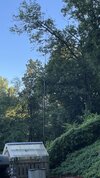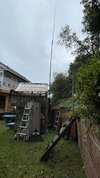I used 2 solid copper wire off each leg of my tower to its own 8 ft copper clad rod. Kept each ground as short as possible.
At work we coil 2 solid put it under the butt of the pole. Throw about 6 inches of dirt on top.. it then runs up the pole hole to about 18 inches above grade. We then nico press sleeve it to 7 #10 copper clad up the pole. It is bonded directly to the transformer and system neutral. For larger devices and higher current applications.. (xformer banks, regulators, inteleruptors, vipers, ocr's) we use #2 stranded copper up the pole. They claim the 7 #10 wire works "as good" as real copper... less theft losses.
At work we coil 2 solid put it under the butt of the pole. Throw about 6 inches of dirt on top.. it then runs up the pole hole to about 18 inches above grade. We then nico press sleeve it to 7 #10 copper clad up the pole. It is bonded directly to the transformer and system neutral. For larger devices and higher current applications.. (xformer banks, regulators, inteleruptors, vipers, ocr's) we use #2 stranded copper up the pole. They claim the 7 #10 wire works "as good" as real copper... less theft losses.



